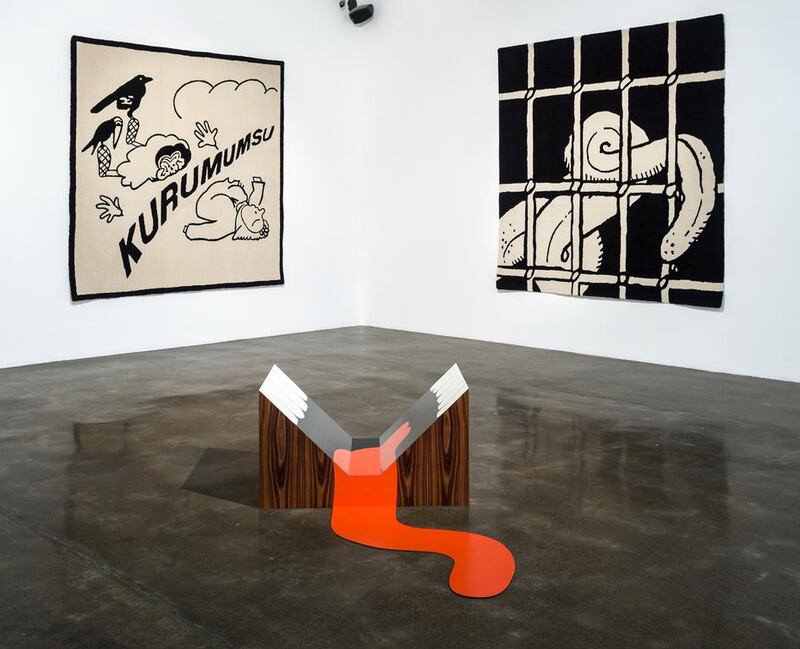When asked to describe their work, Slavs and Tatars say that the best analogy is yogurt: “Yogurt is a bacteria that from one culture grows another, so from yogurt you make more yogurt.”
Slavs and Tatars are an art collective comprising artists who, rather than being identified by their names or nationalities, prefer to be referred to as a whole and beassociated with the mission that they decided on in 2006 – to devote themselves to the Caucasus and Central Asia.
“We are not in any way experts,” they say. “You can’t be an expert on a region that has 300-odd ethnicities and half the world’s population, so we gave ourselves that name from our own brief to explore the region further.”
They have spent the last eight years researching, debating and initiating dialogue in the region using a variety of artistic forms – from publications and public lectures to sculptures, installation and sound in exhibitions all over the world.
Their work has been produced in cycles that often focus on linguistics, ethnic roots and the belief that one idea breeds into another, like the cultures of yogurt or the layers of a Russian nesting doll.
“It is not pedagogical,” Slavs & Tatars explain. “It is critical and political, but we do not preach. We combine things that are not usually put together such as critique and humour and communism and Islam and we maintain a forward-looking perspective.”
During Art Week two weeks ago, Slavs & Tatars opened their first solo show in the Middle East in The Third Line gallery in Dubai. Language Arts talks about language politics and how it is exploited for purposes of identity and nation building.
“Within this body of work, it is not peoples or nations that are liberated, it is phonemes,” explains the gallery in a statement, referring to the basic unit of a language’s phonology. Slavs & Tatars elaborate further: “We are trying to liberate language from its shackles.”
These efforts are shown in a number of art works depicting the tongue. The first is a series of magenta and mauve glass sculptures and the second is a wooden seat of an open mouth with a tongue snaking along the floor.
“There is a lot of sensuality associated with the tongue, and we are interested in how to redeem language’s sensual attributes and sacred uses as opposed to the profane,” they say.
In another section, called Trannie Tease, plaques on the wall bear phrases transliterated into several languages.
The most pertinent of these is a white, vacuum-formed plastic board with green lettering in Arabic spelling out the English phrase “To Beer or Not To Beer”.
In English, the phrase is nothing more than a debased comic term that might be blazoned across a student’s T-shirt, but the roots of the phrase – to be or not to be – is a serious existential question.
“We were interested in redeeming this gravitas,” explain Slavs & Tatars. “By putting this phrase into Arabic script, you regain its original philosophical question because as a Muslim, ‘To beer or not to beer’ could easily translate directly to ‘To be or not to be’.”
It is wry humour that works on many deeply intellectual levels and, in order to fully understand the joke, you would need to be familiar with Arabic, English slang, the works of William Shakespeare and Islamic principles. However, an important point is that even if you don’t understand it, the use of pop culture and its actual composition of bright colour and bubbled plastic makes it visually appealing and therefore attractive.
“There is nothing wrong with seducing the audience even while discussing complex matters,” they say. “We provide critique, but we also provide joy.”
The use of language began as a project called Long Legged Linguistics in Samos, Greece, last year.
It is also the follow-on point from Khhhhhh, a book they published about the phoneme used in the Arab, Russian and Hebrew languages.
“The alphabets we use are not separate from the way we view the universe,” say the group.
The rest of the show contains the Love Me, Love Me Not series of mirrors, which reveal a lexicological tree of city names that have changed over time and with different occupiers and the Love Letters carpet series that features cartoon drawings of attempts to assign Cyrillic graphemes to phonemes in the Turkic languages of the former Soviet Union that previously did not exist in Cyrillic alphabet.
To finish the show, in the project space upstairs, is an audio piece featuring a translation of a Polish poem into Farsi, which highlights the unlikely common histories of Poland and Iran from 17th-century Sarmatism to the 21st-century Green Movement.
Although the stories range vastly across generations and countries and can seem a little overwhelming at times, the different media give the audience a variety of entry points to help to understand their point. But the most fascinating thing about all of their work is that their personal backgrounds have nothing to do with the Caucasus or Central Asia and that this is as much a journey of self-identity as much as an artistic exercise.
“Devoting yourself to something that you don’t know is where true wisdom arises,” they conclude.
• Slavs and Tatars; Language Arts runs until April 17 at The Third Line, Dubai
aseaman@thenational.ae





